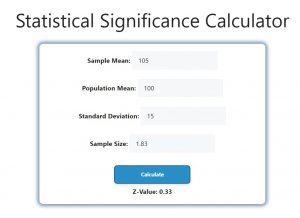About Statistical Significance Calculator (Formula)
A Statistical Significance Calculator is an essential tool for researchers and analysts, helping to determine whether the results of an experiment or study are likely due to chance or if they reflect a genuine effect. By calculating the Z-score, you can assess the probability of observing a particular result if the null hypothesis is true. This calculator aids in making informed decisions based on data, thereby enhancing the credibility of research findings.
Formula
To calculate the Z-score for determining statistical significance, use the following formula:
Z = (x – u) / (std / sqrt(n)),
where x is the sample mean, u is the population mean, std is the standard deviation, and n is the sample size.
How to Use
- Collect Your Data:
Gather the necessary data, including the sample mean (x), population mean (u), standard deviation (std), and sample size (n). - Input Values:
Enter the values into the calculator as prompted. Ensure all numbers are accurately represented. - Calculate Z-score:
Click the calculate button to compute the Z-score. The calculator will provide you with the Z-value, which indicates the statistical significance. - Interpret Results:
Analyze the Z-score to determine if your results are statistically significant based on your chosen significance level (commonly 0.05 or 0.01).
Example
Let’s consider a practical example of using the Statistical Significance Calculator:
- Sample Mean (x): 105
- Population Mean (u): 100
- Standard Deviation (std): 15
- Sample Size (n): 30
Using the formula:
Z = (105 – 100) / (15 / sqrt(30))
Z = 5 / (15 / 5.477)
Z = 5 / 2.738 = 1.83.
In this example, the Z-score is 1.83, which can be compared to a Z-table to determine statistical significance.

FAQs
1. What is a Statistical Significance Calculator?
A Statistical Significance Calculator determines whether your data results are statistically significant by calculating the Z-score.
2. Why is statistical significance important?
Statistical significance helps researchers understand if their findings are due to chance or reflect a true effect in the population.
3. What is a Z-score?
A Z-score measures how many standard deviations a data point is from the mean, indicating its relative position within a distribution.
4. How do I know if my results are statistically significant?
Compare your Z-score to critical values from a Z-table corresponding to your significance level (e.g., 0.05).
5. What significance levels are commonly used?
Common significance levels are 0.05 (5% risk) and 0.01 (1% risk) of concluding that a difference exists when there is none.
6. What do I need to perform a statistical significance test?
You need the sample mean, population mean, standard deviation, and sample size.
7. Can I use this calculator for different types of data?
Yes, it is applicable for various types of data where the Z-test is appropriate.
8. What is the null hypothesis?
The null hypothesis is a statement that there is no effect or difference, serving as a baseline for testing.
9. What does it mean if my Z-score is greater than the critical value?
If your Z-score exceeds the critical value, it indicates that your results are statistically significant.
10. Can I use the calculator for small sample sizes?
For small sample sizes (typically n < 30), consider using a t-test instead of a Z-test.
11. What happens if the Z-score is negative?
A negative Z-score indicates that the sample mean is below the population mean, but it can still be statistically significant.
12. How does sample size affect statistical significance?
Larger sample sizes tend to yield more reliable results, reducing the impact of random variability.
13. Is there a difference between one-tailed and two-tailed tests?
Yes, one-tailed tests assess the probability of an effect in one direction, while two-tailed tests assess both directions.
14. Can I calculate the Z-score manually?
Yes, you can manually calculate the Z-score using the formula, but a calculator simplifies the process.
15. What should I do if my results are not statistically significant?
Consider reviewing your research design, sample size, or effect size to determine potential improvements.
16. Can this calculator be used in different fields?
Yes, it is useful in various fields, including social sciences, healthcare, and business research.
17. How does the standard deviation impact the Z-score?
A larger standard deviation decreases the Z-score, indicating a less pronounced effect relative to the variation in the data.
18. Are there other methods to determine significance?
Yes, methods like p-values, confidence intervals, and t-tests can also assess statistical significance.
19. What is a p-value?
A p-value indicates the probability of obtaining results as extreme as observed under the null hypothesis.
20. Can I rely solely on the Z-score for my conclusions?
While the Z-score is important, consider other factors like p-values, sample size, and effect size for a comprehensive understanding.
Conclusion
The Statistical Significance Calculator is an invaluable tool for researchers and analysts, facilitating the determination of whether results reflect true effects or are simply due to chance. By utilizing the Z-score formula, users can make informed decisions based on their data, enhancing the rigor and credibility of their research findings. Understanding the implications of statistical significance is crucial in various fields, and this calculator provides a straightforward approach to achieving reliable results.